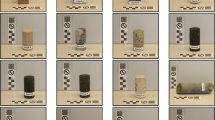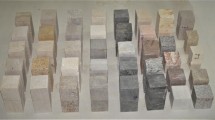Abstract
The Leeb hardness test (LHT with test value of L D ) is a rebound hardness test, originally developed for metals, that has been correlated with the Unconfined Compressive Strength (test value of σ c ) of rock by several authors. The tests can be carried out rapidly, conveniently and nondestructively on core and block samples or on rock outcrops. This makes the relatively small LHT device convenient for field tests. The present study compiles test data from literature sources and presents new laboratory testing carried out by the authors to develop a substantially expanded database with wide-ranging rock types. In addition, the number of impacts that should be averaged to comprise a “test result” was revisited along with the issue of test specimen size. Correlation for L D and σ c for various rock types is provided along with recommended testing methodology. The accuracy of correlated σ c estimates was assessed and reasonable correlations were observed between L D and σ c . The study findings show that LHT can be useful particularly for field estimation of σ c and offers a significant improvement over the conventional field estimation methods outlined by the ISRM (e.g., hammer blows). This test is rapid and simple, with relatively low equipment costs, and provides a reasonably accurate estimate of σ c .






Similar content being viewed by others
References
Aoki H, Matsukara Y (2008) Estimating the unconfined compressive strength of intact rocks from Equotip hardness. Bull Eng Geol Environ 67(1):23–29. https://doi.org/10.1007/s10064-007-0116-z
Asef MR (1995) Equotip as an index test for rock strength properties. Dissertation, ITC Delft
Asiri Y (2017) Standardized process for field estimation of unconfined compressive strength using Leeb hardness. MASc, Dalhousie University, Halifax
Asiri Y, Corkum AG, El Naggar H (2016) Leeb hardness test for UCS estimation of sandstone. In: Canadian Geotechnical Society, 3–5 October 2016, Vancouver
ASTM Standard D4543-08 (2008) Standard practices for preparing rock core as cylindrical test specimens and verifying conformance to dimensional and shape tolerances. ASTM International, West Conshohocken, PA
ASTM Standard D7012-10 (2010) Standard test method for compressive strength and elastic moduli of intact rock core specimens under varying states of stress and temperatures. ASTM International, West Conshohocken, PA
ASTM Standard A956-12 (2012) Standard test method for Leeb hardness testing of steel products. ASTM International, West Conshohocken, PA
Daniels G, McPhee CA, Sorrentino YC, McCurdy P (2012) Non-destructive strength index testing applications for sand failure evaluation. In: SPE Asia Pacific Oil and Gas Conference and Exhibition. Society of Petroleum Engineers
Gorski B, Anderson T, Conlon B (2007) Laboratory geomechanical strength testing of DGR-1 and DGR-2 Core. CANMET
Hack HR, Hingira J, Verwaal W (1993) Determination of discontinuity wall strength by Equotip and ball rebound tests. Int J Rock Mech Min Sci Geomech Abstr 30(2):151–155
Hoek E, Brown ET (1980) Underground excavations in rock. The Institution of Mining and Metallurgy, London
ISRM (1981) Rock characterization, testing and monitoring: ISRM suggested methods. In: Brown T (ed) ISRM Yellow Book. Pergamon Press, Oxford
ISRM (2007) The complete ISRM suggested methods for rock characterization, testing and monitoring: 1974–2006. In: Ulusay R, Hudson JA (eds) Suggested methods prepared by the commission on testing methods, international society for rock mechanics (ISRM Blue Book). Springer, New York
ISRM (2014) The ISRM suggested methods for rock characterization, testing and monitoring: 2007–2014. In: Ulusay R (ed) Suggested methods prepared by the commission on testing methods, international society for rock mechanics (ISRM Orange Book). Springer, New York
Kawasaki S, Tanimoto C, Koizumi K et al (2002) An attempt to estimate mechanical properties of rocks using the Equotip hardness tester. J Jpn Soc Eng Geol 43(4):244–248
Kompatscher M (2004) Equotip—rebound hardness testing after D Leeb. In: Conference on hardness measurements theory and application in laboratories and industries, HARDMEKO 2004, pp 66–72
Koncagul EC, Santi PM (1999) Predicting the unconfined compressive strength of the Breathitt shale using slake durability, Shore hardness and rock structural properties. Int J Rock Mech Min Sci 36(2):139–153
Lee JS, Smallwood L, Morgan E (2014) New application of rebound hardness numbers to generate logging of unconfined compressive strength in laminated shale formations. In: 48th US rock mechanics/geomechanics symposium 2014, vol 2, pp 972–978
Leeb D (1979) New dynamic method for hardness testing of metallic materials. Revista de Metalurgia 15(1):57–63
Meulenkamp F (1997) Improving the prediction of the UCS by Equotip readings using statistical and neural network models. Mem Centre Eng Geol Neth 162(127):85–101
Meulenkamp F, Grima MA (1999) Application of neural networks for the prediction of the unconfined compressive strength (UCS) from Equotip hardness. Int J Rock Mech Min Sci 36(1):29–39
Moore DS (2012) Introduction to the practice of statistics, 7th edn. WH Freeman, New York
Nicksiar M (2013) Effective parameters on crack initiation stress in low porosity rocks. Dissertation, University of Alberta
Okawa S, Ohoka M, Funato A (1999) Application of hardness tester to rock specimens. In: Proceedings of the 29th symposium of rock mechanics, pp 256–260
Ulusay R, Gokceoglu C, Sulukcu S (2001) ISRM suggested method for determining block punch strength index (BPI), draft. Int J Rock Mech Min Sci 38:1113–1119
Ulusay R, Aydan Ö, Erguler ZA, Ngan-Tillard DJM, Seiki T, VerwaaL W, Sasaki Y, Sato A (2014) ISRM suggested method for the needle penetration test. Rock Mech Rock Eng 47:1073–1085
Verwaal W, Mulder A (1993) Estimating rock strength with the Equotip hardness tester. Int J Rock Mech Min Sci Geomech Abstr 30(6):659–662
Verwaal W, Mulder A (2000) Rock and aggregate test procedures. Rock Aggreg Lab Man 13:14
Viles H, Goudie A, Grab S, Lalley J (2011) The use of the Schmidt Hammer and Equotip for rock hardness assessment in geomorphology and heritage science: a comparative analysis. Earth Surf Proc Land 36(3):320–333
Yilmaz N (2013) The influence of testing procedures on uniaxial compressive strength prediction of carbonate rocks from Equotip hardness tester (EHT) and proposal of a new testing methodology: Hybrid dynamic hardness (HDH). Rock Mech Rock Eng 46(1):95–106
Acknowledgements
The authors would like to acknowledge the financial support of the Saudi Arabian Cultural Bureau in Canada scholarship. BGC Engineering Inc. provided access to their collected LHT data. Mr Jesse Keane assisted with much of the laboratory testing, and his help was appreciated. The manuscript was kindly edited by Judy MacLean. Furthermore, we would like to thank the journal’s anonymous reviewers for their effort and constructive comments.
Author information
Authors and Affiliations
Corresponding author
Rights and permissions
About this article
Cite this article
Corkum, A.G., Asiri, Y., El Naggar, H. et al. The Leeb Hardness Test for Rock: An Updated Methodology and UCS Correlation. Rock Mech Rock Eng 51, 665–675 (2018). https://doi.org/10.1007/s00603-017-1372-2
Received:
Accepted:
Published:
Issue Date:
DOI: https://doi.org/10.1007/s00603-017-1372-2




